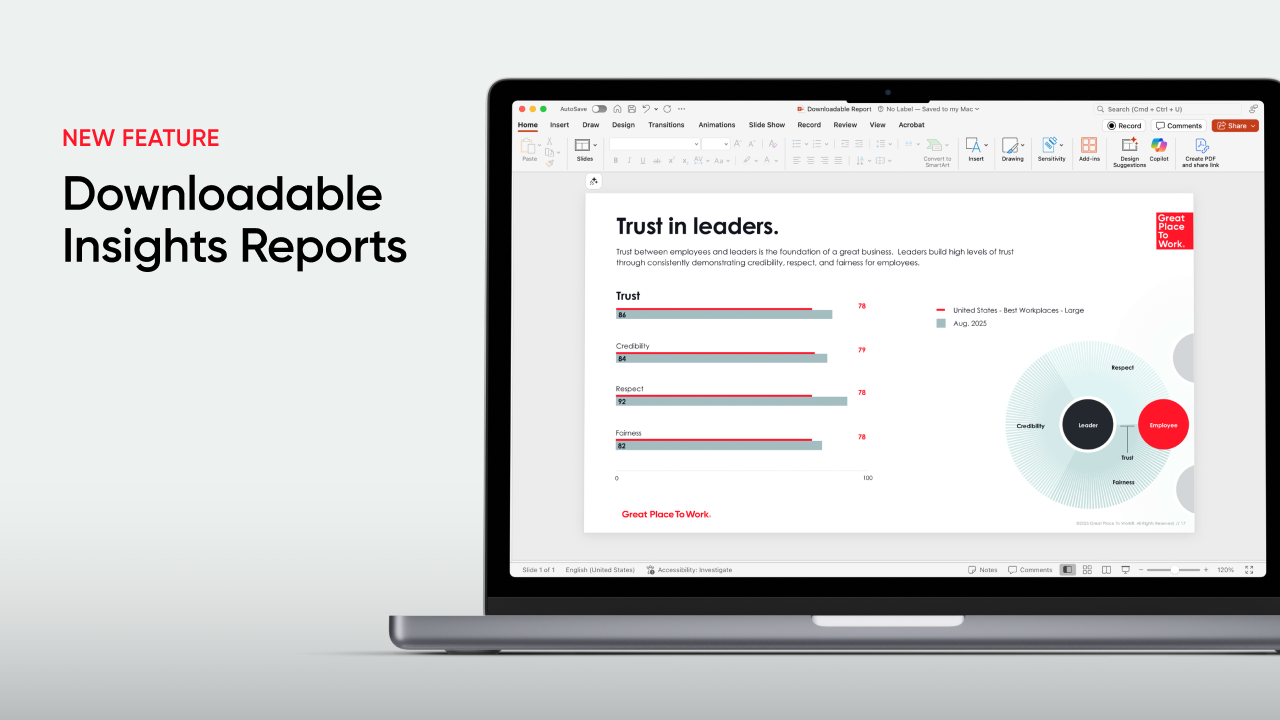Workplace flexibility empowers employees to do their best work. Here’s how the high-trust companies build a successful asynchronous culture.
While organizations are calling for employees to “return to premise,” it’s team cooperation, not proximity, that drives productivity.
In other words: let people work how they work best.
Our report, “Return-to-Office Mandates and the Future of Work,” supports this. When individuals or teams tailor policies to their needs, the result is striking — more employees are willing to go the extra mile.
An asynchronous work culture grants employees the freedom to choose how and when they work best. It also fosters collaboration and inclusivity, and improves work-life balance and productivity.
We see this at the 2025 Fortune 100 Best Companies to Work For®. Of the 100 companies, 97 support flexible work. Employees at the 100 Best Companies go the extra mile — productivity is nearly 42% higher at these companies compared to a typical U.S. workplace.
Workplaces that allow employees to choose when and where they work are the ones that flourish in the global market. The key is to ground asynchronous practices in trust, clarity, and intentional design.
What is asynchronous work and why does it matter?
Asynchronous work (also called “async”) is a model where team members collaborate without needing to be online or in the office to work at the same time. This model of working accommodates employees’ differing time zones and work schedules. Asynchronous work differs from remote work – although both can happen simultaneously. Asynchronous work is defined by when work is completed, rather than where.
Examples of asynchronous work include:
- Sending an email
- Making edits to a shared document
- Recording a video message for a coworker
- Using a messaging platform to ask a question about KPIs
- Checking the status of a task in your team’s project management software
Asynchronous work benefits employees and organizations by supporting flexibility, reducing meeting fatigue, and frees up individuals to focus and engage in deep work on their own schedule.
Core foundations of asynchronous work culture
Here is how top workplaces support global teams and an async-first work culture:
Set clear expectations and shared goals
Working effectively in an asynchronous culture requires a mind shift for leaders and employees alike. It’s important for leaders to set the tone with clear expectations around roles, deadlines, and work output.
- Alleviate potential conflict by aligning employees on the expectations around communication and work output
- Define response times and establish expectations on how quickly team members will respond to requests, especially if they’re in a different time zone
- Ensure information is well-documented and available in a central location
- Establish a practice of employees sharing relevant documents ahead of real-time meetings, so each team member has time to review and can contribute asynchronously
- Leaders can prompt team members to provide regular updates and use project management tools to track progress transparently
Use communication tools intentionally
The best communication tools are the ones your people will actually use. Choose tools that work best for async collaboration without overwhelming employees with multiple apps that do a similar job.
Project Management — Tools such as Asana and Trello allow teams to manage tasks, set deadlines, leave comments, and track progress async.
Flexible communication — With Slack, teams can set up various channels and direct messaging can be useful for async communication without resorting to email. Loom lets users create and share video updates, saving people time in writing down detailed explanations or providing feedback to shared projects.
Documentation — Facilitate documentation with all-in-one applications like Notion, which combines note-taking and data organization for efficient communication. Confluence is another widely used platform where individuals can collaborate on project documentation.
Document everything
When colleagues are not working in real-time, it becomes even more critical that team members document their processes, schedule, and updates as a source of truth. This way, everyone can stay informed and contribute, even if they’re not working at the same time. Documentation also helps reduce misunderstanding and foster accountability.
To make it easy, set up a central hub or doc with logins, Frequent Asked Questions (FAQs), and Standard Operating Procedures (SOPs) so no one’s hunting for info.
At DHL Express, the “Smart Connect” intranet serves as a comprehensive hub for 116,000 employees worldwide, providing access to local news, company policies, strategic updates, and HR tools.
Designed to bridge operational and office divisions, the platform delivers content in local languages and offers personalized self-services, including payroll, attendance systems, job portals, and learning platforms.
Normalize asynchronous updates
Asynchronous work requires a shift in traditional ways of working. Normalize practices like weekly written updates in lieu of in-person meetings, schedule asynchronous stand-ups that don’t require real-time participation, and offer feedback via recorded videos.
Normalizing async updates also cultivates a culture of trust. A Remote Work Productivity Study shows that when leaders openly share updates and make new ways of collaboration feel like the norm, it builds credibility.
At Salesforce, the company holds regular “Ohana Meetings” where employees from different departments can ask questions and share updates. This practice has helped break down silos and foster a culture of transparency and cooperation.
Lessons from Certified™ companies doing async right
Atlassian’s “Team Anywhere” policy allows employees to choose when and where they work
Atlassian seeks to be a pioneer in the era of distributed work by creating “Team Anywhere.” This work policy is structured around three key elements: talent everywhere, flexible work experience, and reimagined teamwork.
The IT company opened its doors to registered offices in 14 countries and provides people with the option to relocate between any of them. They can also spend up to 90 days working outside their preferred work location. This gives employees the freedom to continue building their career while experiencing another country or relocate to be with family.
To ensure team members successfully work async, the company orientates around time zones instead of a physical office, setting a minimum of 4 hours of overlap, so global teams have time each day to collaborate synchronously.
Atlassian also encourages virtual meetings and places greater emphasis on asynchronous communication. This levels the playing field so employees never feel like their flexible working arrangements holds them back.
As a result, 91% of employees say Team Anywhere is an important reason for staying at Atlassian, and 92% say it allows them to do their best work.
How CrowdStrike sets employees up for success from day one
CrowdStrike supports asynchronous work by ensuring that employees are set up for success from day one. New hires are provided with laptops before they start, so they have the tools they need to make meaningful connections, and know who to go to, when, and how.
Throughout the first 90 days, the IT company offers various virtual workshops and events to foster connections and support throughout their onboarding process. Whether new hires are hybrid or remote, they feel supported: 98% of employees say “when you join the company, you are made to feel welcome.”
Zillow employees wrap their work around their lives, not the other way around
Zillow shares that their ultimate goal is to change the shape of work itself. To reach that aim, employees are given the flexibility to wrap their work around their lives, rather than basing their lives on their work schedules.
Their rationale is simple: The ability to recharge during time off, appropriate workload, and work-life balance are three factors that contribute to well-being, according to employee surveys.
With employees spread across the country, Zillow is intentional about building smart working norms that connect people working asynchronously. The company holds core collaboration hours across all time zones to ensure employees have time to engage with one another.
Zillow also leverages digital technologies to foster relationships within teams and across the company, whether people are working in person for shorter stints or connecting for a virtual coffee chat with fellow members of nine Employee Resource Groups (ERGs).
Flexible working arrangements help contribute to Zillow’s company culture, where 93% of employees at Zillow Group report it is a great place to work and 95% people say they’re proud to tell others they work there.
Balancing asynchronous and synchronous communication
As evidenced from examples of Best Workplaces, working asynchronously doesn’t mean real-timecommunication shouldn’t take place. There are going to be essential business functions that demand synchronous communication.
The key for leaders is to recognize where work can be completed async and where real-time interaction is necessary, such as complex-problem-solving or onboarding.
While CrowdStrike supports an asynchronous work culture, new hires are also required to attend three synchronous, virtual workshops. These take place approximately 30, 60, and 90 days after new hires start, and ensure a continuous journey of support throughout their onboarding process.
Synchronous communication plays a vital role in team building, which is key to fostering a strong company culture. Research from Great Place To Work® backs this up: social connection and having fun in the workplace drivehigher levels of well-being for all ages of workers.
Lex Machina brought their people together with a virtual “campfire,” complete with a professional storyteller and camp singer who led employees in campfire songs. The company also mailed team members kits with marshmallows and graham crackers so everyone could make s’mores.
Atlassian fosters a sense of camaraderie with Atlassian on Tour, a series of pop-up events in non-office cities around the world designed to bring employees together without the need to travel far.
Here are four ways leaders can maximize productivity and foster connection in remote teams:
1. Enable your teams to meet their unique needs — Leaders should understand the needs of each team as well as the needs of the business.
2. Push for transparency — Make conversations about projects available on a public platform, such as Teams. This ensures everyone has equal access to information and can catch up on projects organically.
3. Recommit to listening — Listening is one of the most important high-trust leadership behaviors leaders should model. Survey your people and make sure remote work policies have plenty of input from the people who will be affected by them.
4. Demand that in-person meetings are purpose driven — When people are coming together in-person, ensure the meeting has a robust agenda, clearly communicate its intended outcomes, and make every moment count.
Common pitfalls in asynchronous work culture (and how to avoid them)
While employees want flexibility in when they work and where, there are still pitfalls leaders should be aware of in creating an asynchronous work culture:
Delay in decision-making
Communication in an async work culture isn’t swift, which can lead to frustration when team members need answers in real-time. This delay can also draw out timelines on projects.
Set employees up for success by establishing clear expectations around response times. CrowdStrike not only gives employees the tools they need to succeed but also familiarizes team members with how collaboration happens and where to access information efficiently.
Feelings of isolation
Loneliness at work is a very real problem. Async team members may have less real-time connection than their in-person colleagues and feel this isolation more. Gallup’s “State of the Global Workplace” report found that fully remote workers not only report lower well-being, but higher instances of stress, anger, and loneliness.
Leaders play a role in supporting social interaction, structure, and mental health alongside flexibility. World Wide Technology addressed loneliness among their people by implementing a storytelling program to help employees connect and ensure each employee feels valued and connected.
Communication silos
While an asynchronous work culture can be beneficial for focused work, it can also lead to communication silos, as team members find themselves working in isolation or have limited communication with different departments or leaders.
Break down silos and foster a culture of communication with regular feedback from employees. Pulse surveys play a role in creating a responsive, employee-centric workplace culture, whether people work async or in real-time. Pulse surveys give leaders insight into employee sentiment and help identify areas for improvement.
At Brains, leaders conducted a “listening tour” and gathered feedback from employees. The answers helped them identify key priorities, such as improving collaboration and transparency.
Fostering inclusion and well-being in asynchronous environments
The advantages of asynchronous work environments go beyond flexibility, greater focus on tasks, and increased productivity. Reimagining the workplace where people aren’t tethered to a location or 9-to-5 schedule can help level the playing field for employees by reducing bias and allowing other voices to be heard.
An asynchronous culture fosters inclusion and supports people who may normally require accommodations, including people with disabilities and neurodivergent employees. Divergent employees can struggle with certain forms of communication and an async work culture helps accommodate by providing improved communication programs and more inclusive collaboration tools. Neurodiverse people also don’t need to face uncomfortable social situations like making small talk.
For people with disabilities – a group of individuals with invaluable skills and knowledge – flexible work frees someone with chronic pain from driving into an office or a person with a disability that prevents them from working set hours.
Having an inclusive and flexible workplace culture will not only help you attract a diverse set of talent but also help you retain the diverse talent you attracted in the first place.
A flexible workplace is an investment in employee’s well-being. Employees who experience high levels of well-being in the workplace are three times more likely to intend to stay with their employer and three times more likely to recommend their employer to others.
A recent Employee Well-Being Report from Great Place To Work® and Johns Hopkins analyzes more than 1.5 million employee responses collected from over 2,500 organizations via the Trust Index™ Survey. The research highlights how a positive workplace climate drives well-being and actionable steps for leaders to improve team wellness.
The future of asynchronous remote work
Async work is shaped by trends that will see it continue to evolve:
AI-driven productivity tools — AI-powered tools can enhance asynchronous work by automating tasks, such as summarizing meetings so team members won’t need to attend in real-time, or using chatbots to guide employees through processes without the need for human interaction.
Global workforce management — Gives companies an advantage in expanding their talent and hiring people globally, based on their skills, regardless of where they are located.
Outcome-based performance tracking — Supports outcome-based performance, minimizing interruptions, enabling focused work, and supporting deeper engagement on outcome-based tasks.
Encourage continuous adaptation rooted in employee feedback — Helps organizations unlock the full potential of employees. Based on employee feedback, leaders can test new ways of working that increase agility, innovation, and productivity.
Build a flexible, high-trust workplace with asynchronous work
The foundations of a successful asynchronous remote workplace is trust, transparency, and employee-centered systems. That starts by listening. Our employee survey solution provides real-time insights to optimize async strategies and build high-performing teams.








